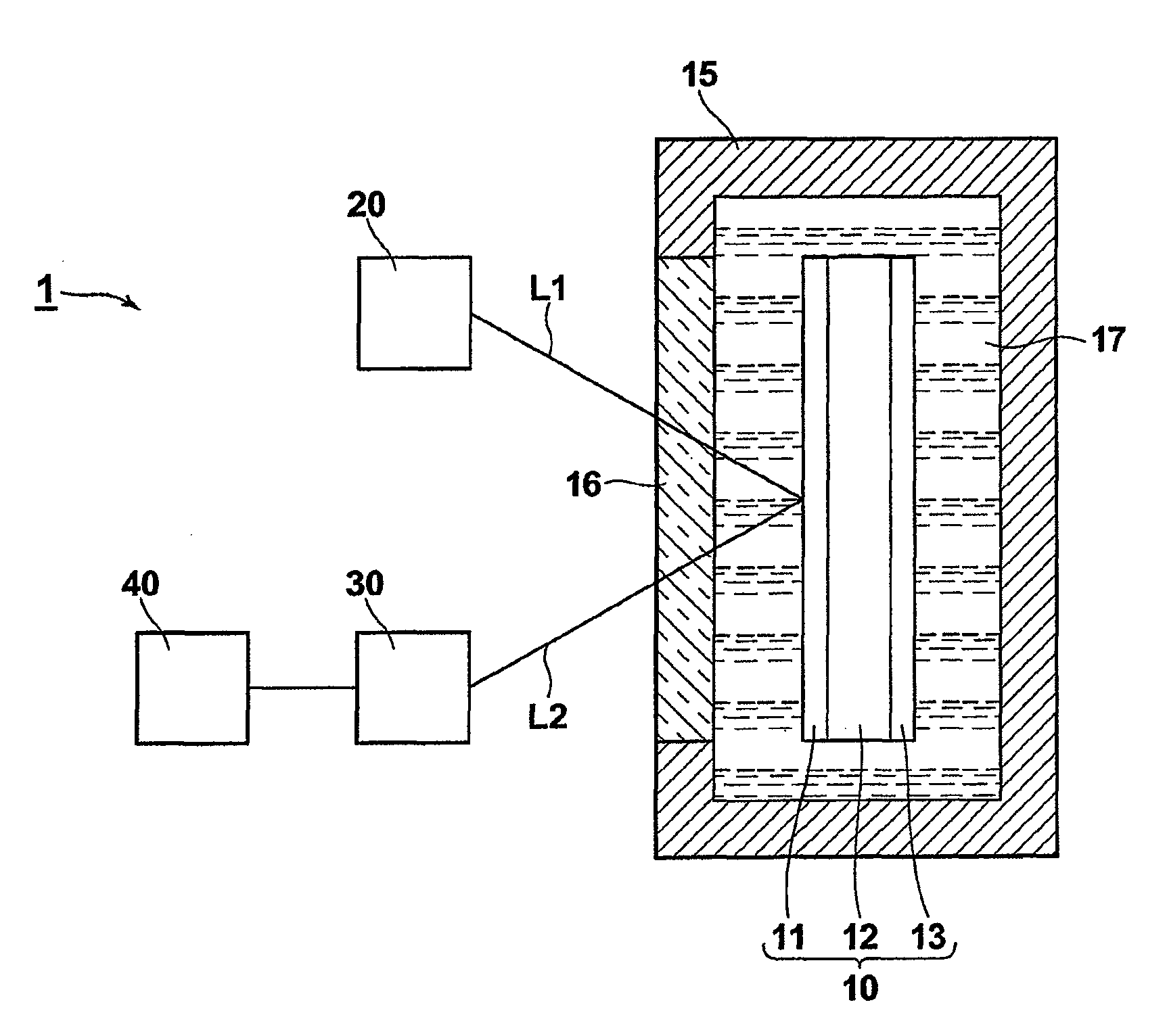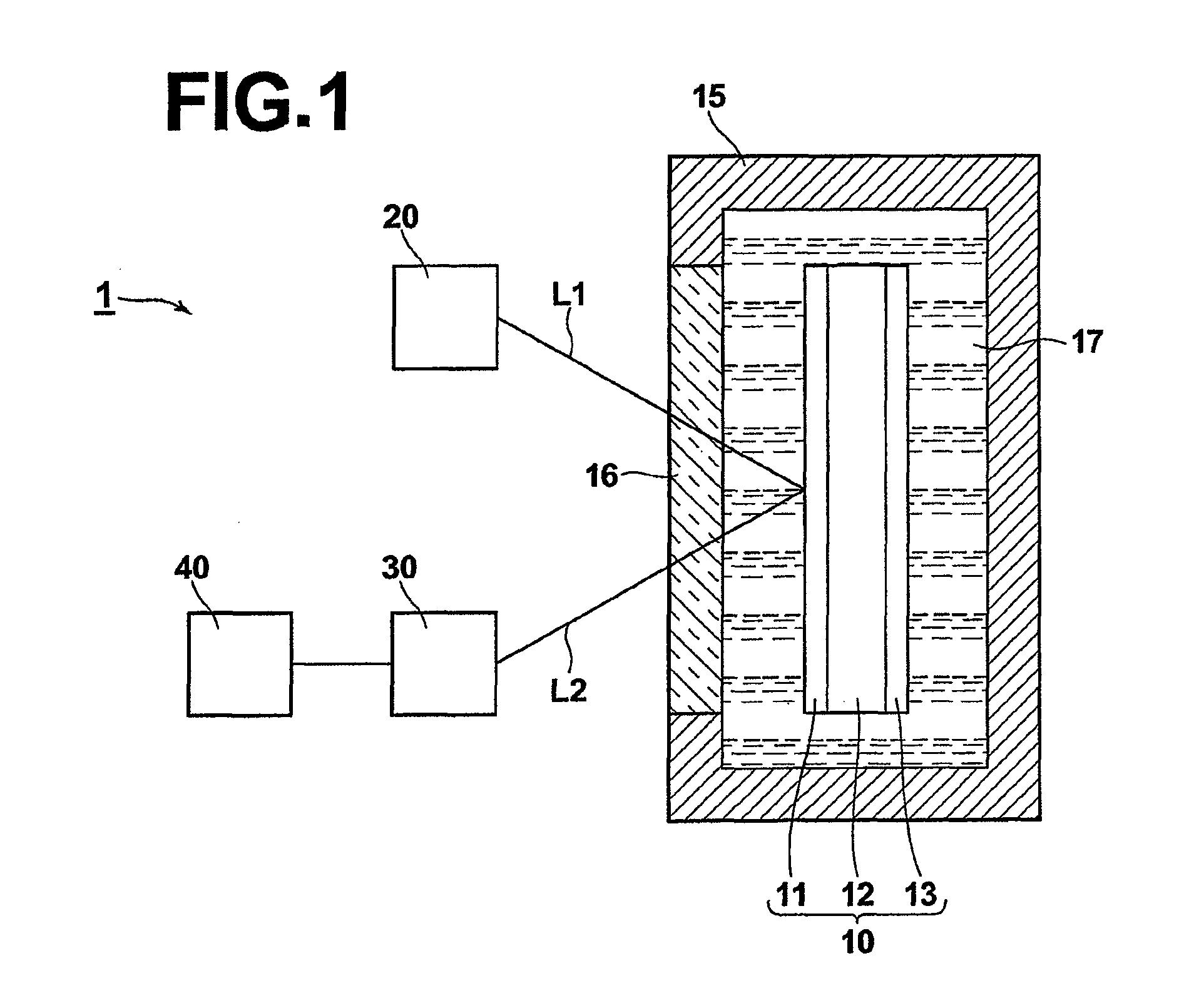Sensing system
a sensing system and sensor technology, applied in the field of sensing systems, can solve the problems of difficult high-precision analysis using local plasmon sensors, high cost of surface plasmon sensors, and severe structural constraints, and achieve the effect of simple construction and satisfying detection sensitivity
- Summary
- Abstract
- Description
- Claims
- Application Information
AI Technical Summary
Benefits of technology
Problems solved by technology
Method used
Image
Examples
first embodiment
[0062]FIG. 1 is a plan view of a sensing system 1 according to a first embodiment of the present invention. The sensing system 1 comprises a sensing element 10, a specimen cell 15, a light injection unit 20, a light detection unit 30, and a data processing unit 40.
[0063]When light L1 for measurement (hereinafter referred to as measurement light L1) is injected onto the sensing element 10, the sensing element 10 outputs output light L2 having a physical characteristic which depends on a specimen 17. The specimen cell 15 contains the sensing element 10 and the specimen 17, and the light injection unit 20 injects the measurement light L1 onto the sensing element 10. The light detection unit 30 detects the physical characteristic of the output light L2, and outputs a signal representing the detection result. The data processing unit 40 performs analysis of the specimen 17 on the basis of the signal outputted from the light detection unit 30.
[0064]First, the sensing element 10 is explain...
second embodiment
[0104]A sensing system according to the second embodiment of the present invention is explained below with reference to FIG. 4, which is a schematic diagram illustrating a light injection unit 20-1 used in the sensing system according to the second embodiment.
[0105]The light injection unit 20-1 illustrated in FIG. 4 is different from the light injection unit 20 illustrated in FIG. 3 in that the beam splitter 132 and the reflective grating 133 in FIG. 3 are replaced with a partially-reflective grating 134 in FIG. 4. The wavelength stabilizing arrangement 130A in the light injection unit 20-1 is realized by the partially-reflective grating 134. The partially-reflective grating 134 is arranged in the optical path of the measurement light L1 directed to the sensing element 10, and reflects a portion of the measurement light L1. The reflected measurement light L1 is fed back to the semiconductor laser 100 through the half-wavelength plate 131, so that the oscillation wavelength of the se...
third embodiment
[0106]A sensing system according to the third embodiment of the present invention is explained below with reference to FIG. 5, which is a schematic diagram illustrating a light injection unit 20-2 used in the sensing system according to the third embodiment.
[0107]In the light injection unit 20-2 illustrated in FIG. 5, a reflective grating 133 and a collimator lens 135 are arranged on the backward side of the semiconductor laser 100, and the collimator lens 120 and the half-wavelength plate 131 are arranged on the forward side of the semiconductor laser 100, so that an optical feedback system realizing a wavelength selection arrangement 130B is formed. The wavelength stabilizing arrangement 130B in the light injection unit 20-2 is realized by the reflective grating 133 and the collimator lens 135. That is, the light emitted backward from the semiconductor laser 100 (backward emission light L1Q) is collimated by the collimator lens 135 and is then incident on the reflective grating 13...
PUM
| Property | Measurement | Unit |
|---|---|---|
| width | aaaaa | aaaaa |
| width | aaaaa | aaaaa |
| dielectric constant | aaaaa | aaaaa |
Abstract
Description
Claims
Application Information
 Login to View More
Login to View More - R&D
- Intellectual Property
- Life Sciences
- Materials
- Tech Scout
- Unparalleled Data Quality
- Higher Quality Content
- 60% Fewer Hallucinations
Browse by: Latest US Patents, China's latest patents, Technical Efficacy Thesaurus, Application Domain, Technology Topic, Popular Technical Reports.
© 2025 PatSnap. All rights reserved.Legal|Privacy policy|Modern Slavery Act Transparency Statement|Sitemap|About US| Contact US: help@patsnap.com



